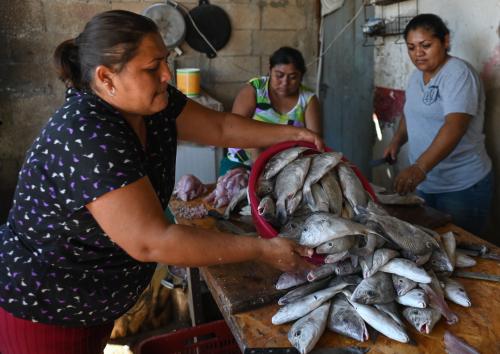Editor’s Note: On September 4-5, 2013, Ernesto Talvi, director of the Brookings Global-CERES Economic and Social Policy in Latin America Initiative (ESPLA) spoke at the “XVII Annual CAF Conference,” an event hosted by the Development Bank of Latin America (CAF), the Organization of American States and the Inter-American Dialogue.
This is an excellent time to take stock of and reflect on the Latin America’s future since we are at the beginning of the end of an extraordinary cycle for many countries in the region, mostly for the commodity-exporting and less-dependent-on-the-U.S.-cycle South America.
Up until the recent deceleration, Latin America had a run of exceptional growth rates between 2004 and 2011, almost doubling its long-run average, with a brief interlude in 2009 in the aftermath of the Lehman crisis.
Sustained growth and income gains interrupted 50 years of relative decline of the region vis-à-vis the U.S.: Latin America’s income per capita declined from 50 percent of that of the U.S. in the 1950s to 23 percent in 2004. It now stands around 30 percent.
Sustained growth and income gains together with active redistribution policies—made possible by the abundance of fiscal resources associated with high commodity prices and high growth rates—also led to a 13 percentage point reduction in poverty rates, a 5 percentage point reduction in extreme poverty rates and to the emergence of the so-called “middle classes” in the region as measured by income. This process was underpinned by formidable progress in the consolidation of electoral democracy and sound macroeconomic policies.
In fact, capital inflows to Latin America tripled since the onset of the financial crisis and came to our shores to buy land, property, businesses, bonds, stocks and bank deposits…
So why is this panel discussing how to achieve economic transformation in the region? Didn’t we already witness a formidable transformation in the last few years? I suspect that there is a feeling out there—and the econometric research to support it—that this spell of high growth and income gains was largely propelled by a formidably favorable external environment: very cheap and abundant financial and capital resources mostly freed up by the financial crisis in the U.S. and Europe. In fact, capital inflows to Latin America tripled since the onset of the financial crisis and came to our shores to buy land, property, businesses, bonds, stocks and bank deposits, generating an asset price boom, a credit boom and an acceleration in aggregate demand and growth. Commodity exporters received the additional boost of very high commodity prices. When the impact of these two factors on growth is taken into account, underlying growth in Latin America was not very different from its historical average. The same can be said about total factor productivity. In other words, when measured appropriately, growth and productivity performance was far from exceptional.
This econometric evidence is fully consistent with the fact that educational achievement failed to improve in Latin America throughout the boom period. According to the Program for International Student Assessment (PISA) scores in math, science and reading comprehension, administered to 15-year-olds in 65 countries around the world—60 percent of which are emerging—50 percent of Latin American students performed below critical levels, very similar levels, on average, as a decade ago. In plain English, this means that one in every two youngsters that are at the final stages of compulsory education and a few steps away from entry into the labor market do not have the minimum set of skills to participate productively in the labor market. In addition, they have learning gaps that will be very difficult to compensate for in later stages of life.
This evidence on educational achievement reinforces the idea that growth performance in the region was inflated by very favorable external conditions rather than being “productivity induced.” Moreover, it also means that poverty, as measured by “skills” and not by income, is still very high and that the so-called emerging middle classes are still precarious.
Moreover, the distribution of educational achievement worsened during the economic boom for the worst reason: It improved significantly in the very favorable socio-economic contexts (the upper quintile) and failed to improve in very unfavorable socio-economic contexts (the lower quintile). In fact, 70 percent of the students in very unfavorable contexts performed below critical levels.
Latin America is now at the end of a cycle of exuberance. Countries that enjoyed very high growth rates started to cool off two years ago.
This social fracture feeds informality as the acute lack of skills precludes formal employment. It may degrade institutions by generating dependence on the State and potentially breeding opportunistic behavior by populist politicians, and it is a seedbed for criminal activities. Not surprisingly, the economic boom did not bring about a reduction in crime rates. In a fragmented society where large groups of citizens do not have the skills to share society’s increasing prosperity, crime is an increasingly tempting avenue through which to appropriate the part of a prosperity that accrues to others but does not accrue to me.
Latin America is now at the end of a cycle of exuberance. Countries that enjoyed very high growth rates started to cool off two years ago. Nevertheless, inflows of cheap external capital continued to finance excess spending (increasingly consumption spending, both public and private) over income. As world financial conditions tightened and capital inflows slowed down, currencies and asset prices in emerging markets plunged across the board, from India to Turkey, from Indonesia to Brazil. Under tighter financial conditions, imbalances of spending over income must be gradually eliminated. Doing so without major macroeconomic disruptions and social unrest—as expectations are frustrated by lower growth and resources to redistribute become scarce—poses a significant challenge for the stability of the region.
However, the challenge of building a lasting and shared prosperity and of building more cohesive and humane societies will require a sustained effort to improve the level and the distribution of academic achievement. Without it, our societies will not be transformed.


Commentary
The Recent Economic Exuberance Cycle in Latin America: A Short-Lived Mirage or Deeply Rooted Transformation?
September 4, 2013